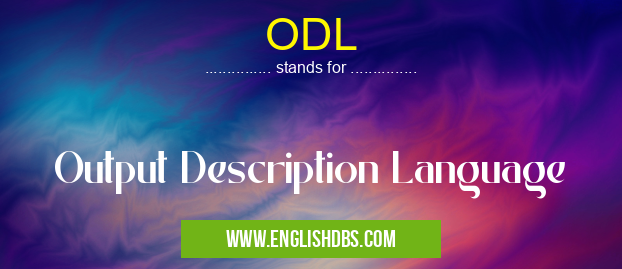What does ODL mean in LANGUAGE & LITERATURE
ODL stands for Output Description Language, a programming language used to define the structure and content of data that is sent to a printer. It provides a way to control the formatting, layout, and appearance of the printed output.

ODL meaning in Language & Literature in Academic & Science
ODL mostly used in an acronym Language & Literature in Category Academic & Science that means Output Description Language
Shorthand: ODL,
Full Form: Output Description Language
For more information of "Output Description Language", see the section below.
Key Features
- Document Structure: ODL defines the logical structure of a document, including sections, paragraphs, and headings.
- Formatting Attributes: It allows for the specification of various formatting attributes such as font, size, color, alignment, and spacing.
- Page Layout: ODL provides control over page layout elements, including margins, page size, and orientation.
- Data Manipulation: It enables the manipulation and extraction of data from databases or other sources to populate printed documents.
Benefits of ODL
- Consistent Output: ODL ensures consistent formatting and appearance of documents across different printers and platforms.
- Increased Efficiency: It reduces the need for manual formatting, saving time and effort.
- Improved Readability: Proper formatting enhances the readability and comprehensibility of printed documents.
- Customizable Output: ODL allows for the creation of tailored output to meet specific requirements.
Essential Questions and Answers on Output Description Language in "SCIENCE»LITERATURE"
What is Output Description Language (ODL)?
Output Description Language (ODL) is a formal language used to describe the layout and content of output documents, such as reports and forms. It is a part of the IBM Informix database management system.
What are the key features of ODL?
ODL provides various features for output document design, including:
- Defining the layout and structure of the output using page, band, and field objects.
- Formatting and styling options for text, numbers, dates, and other data types.
- Computed field expressions for deriving values and performing calculations.
- Conditional formatting and suppression rules to control the display of data.
- Support for various output formats, such as PDF, HTML, and text.
How is ODL used in practice?
ODL is typically used by database administrators and developers to create and modify output documents for reports, invoices, and other business documents. It allows them to define the desired layout and content of the output without having to rely on hard-coding in a programming language.
What are the benefits of using ODL?
Using ODL offers several benefits:
- Improved report quality and consistency by providing a standardized approach to output design.
- Reduced development time and maintenance effort by simplifying the creation and modification of output documents.
- Increased flexibility and control over output formatting, allowing for easy customization to meet specific requirements.
Are there any limitations to using ODL?
ODL is primarily designed for use within the IBM Informix database environment. It may not be as widely supported in other database systems or programming languages. Additionally, ODL may require some technical expertise to use effectively.
Final Words: ODL is a valuable tool for controlling the output of printing devices. It provides a structured and efficient way to define the format and content of printed documents, ensuring consistent and professional-looking output. By leveraging the capabilities of ODL, organizations can optimize their printing processes and enhance the quality of their printed communications.
